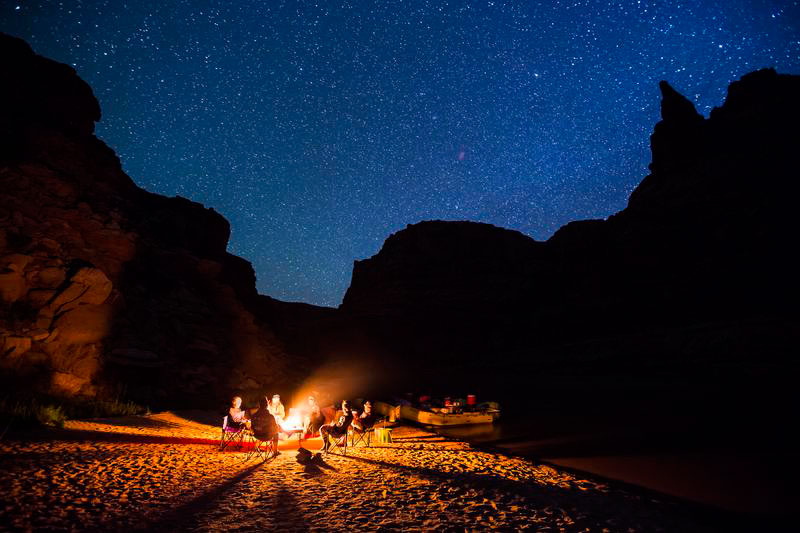There’s something so magical about seeing the night sky come alive, whether it’s watching a colorful harvest moon float above the horizon or noticing that Venus is extra bright. Most of the time, I learn about an upcoming astronomical event at the last minute, meaning I’m hastily setting an alarm for 2 AM and squinting to see the night sky from my backyard.
I live in a relatively small city, so I can often catch a glimpse. Still, it’s no match for the experience of catching a meteor shower in the backcountry, especially from a campsite on the river. These five river trips are worth making it onto your bucket list anytime, but plan them to coincide with an astronomical event, and they’ll blow your mind.
The Best River Trips for Astronomy Lovers

Planetary conjunction // Colorado River, Utah
Bring your camera for this one. Most Septembers, Mars gets close enough to view with the naked eye. Often, another planet approaches closely enough that they’re said to conjoin—that is, they appear to be close together in the night sky, and adept photographers can capture them in the same shot. One of the best places to catch glimpses of any planet is near a Dark Sky Park with minimal light pollution. Canyonlands National Park fits that bill, and paddlers can access one of the most remote and unspoiled regions of the park by rafting the mighty Colorado through the towering red cliffs and wild whitewater of Cataract Canyon. Bonus: by now, summertime temps start to subside, and lower water levels have uncovered some of the best sandy beach camps on this stretch of the river.

Fall Equinox // Rogue River, Oregon
When the autumnal equinox arrives in late September, daylight and nighttime hours are roughly equal—meaning you’ll have plenty of time to check out the fall constellations as they make their way into the night sky. The Rogue River winds its way through the scenic Siskiyou Mountains, whose remoteness lends itself to dark skies perfect for viewing the stars. This time of year, the canyon is quiet, and there’s still plenty of splashy action and the beginnings of some colorful fall foliage to be had during the day. Keep your eyes peeled for constellations in the Perseus family, like Pegasus, Andromeda, and Cassiopeia.

Orionids Meteor Shower // Colorado River, Arizona
The Grand Canyon has a way of reminding humans just how tiny we are in the grand scheme of geologic time, and if you’re looking to double that feeling, a fall rafting trip through the canyon is the perfect time to do it. Not only is it a great time to catch the Milky Way as it lights up the night sky, but in mid-to-late October, the Orionids Meteor Shower is at its peak. This shower can see up to 20 meteors—debris from Halley’s Comet—per hour. To see more meteors, do your homework before you leave by picking out the constellation Orion, which is where the exceptionally fast-moving meteors in this shower emanate from.

Geminids Meteor Shower // Rio Grande River, Texas
The mighty Rio Grande charts a scenic course through canyons up to 1,500 feet deep on its way to the Gulf of Mexico, and nowhere is it more beautiful than in Big Bend National Park. Of course, summer temperatures here can be brutal, which is why the winter months are the perfect time for a float trip. For the most bang for your buck, plan a trip in mid-December, when the Geminids are at their peak. Unlike many others, this meteor shower isn’t caused by comet debris, but from an object that’s thought to be an asteroid. Astronomers have noticed that it intensifies each year, often boasting 120 or more meteors per hour.

Perseid Meteor Shower // Middle Fork Salmon River, Idaho
There’s no bad time for a Middle Fork Salmon rafting trip—I know more than one guide who says if they had to pick just one more river trip in their life, this would be it—but mid-August is a really good time. The Middle Fork is incredibly remote, and it runs right at the edge of an International Dark Sky Reserve, which means there’s virtually no light pollution to distract from the Perseids. This meteor shower happens every year as the earth passes through cosmic debris from the Swift-Tuttle Comet. It’s known for putting on a spectacular show: meteors fly by at an estimated 36 miles per second, and the friction causes the phenomenon we know as shooting stars.
Request a Free Adventures Catalog
Photos: Night sky on a Cataract Canyon rafting trip – Whit Richardson; Rogue River rafting trip – James Kaiser; Milky Way in Grand Canyon – Tom Gotchy; Big Bend National Park by David Morris/Unsplash; Middle Fork Salmon River camp – Justin Bailie
The post 5 Cool Astronomy Events and Where to See Them appeared first on OARS.


Recent Comments